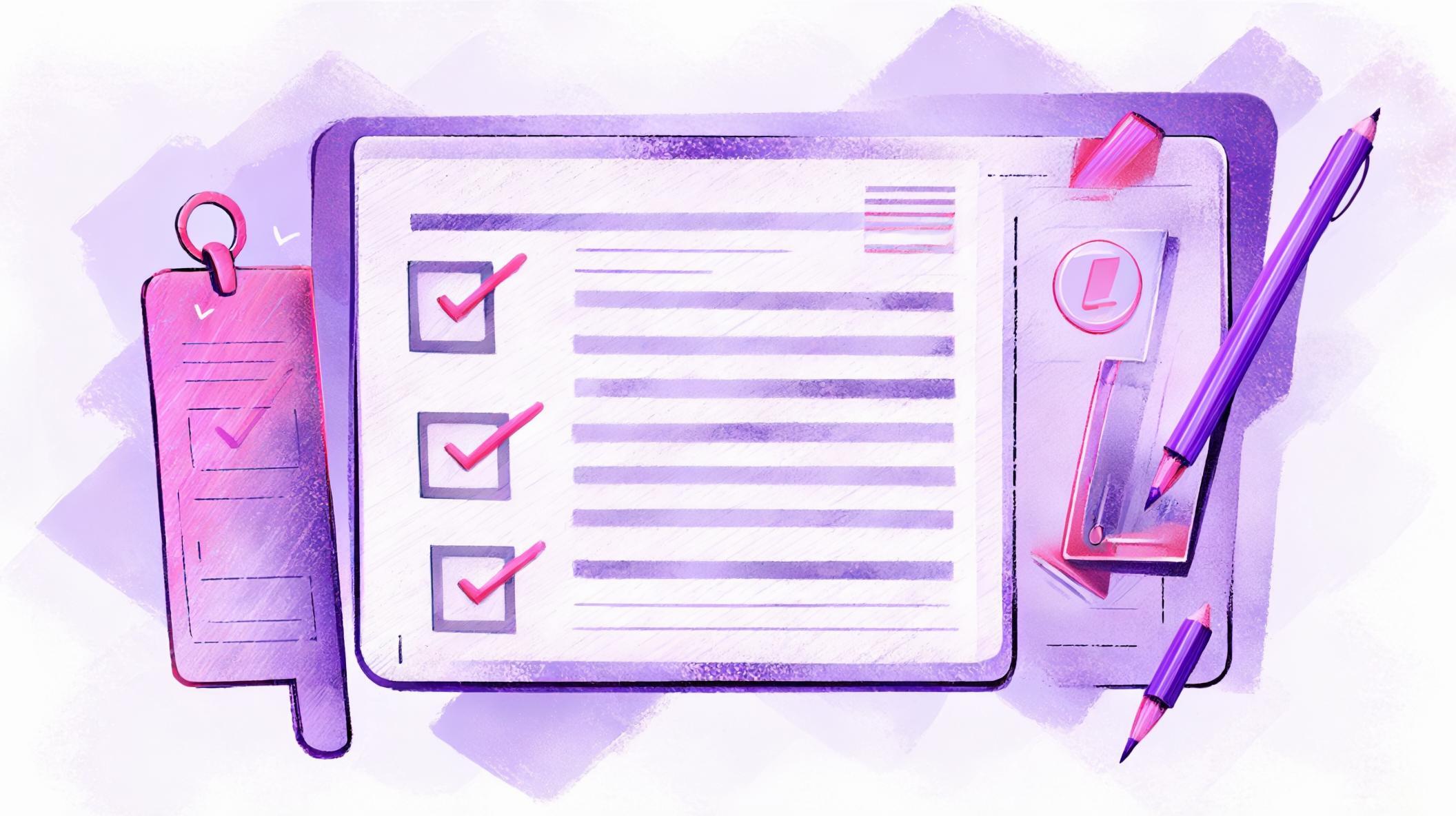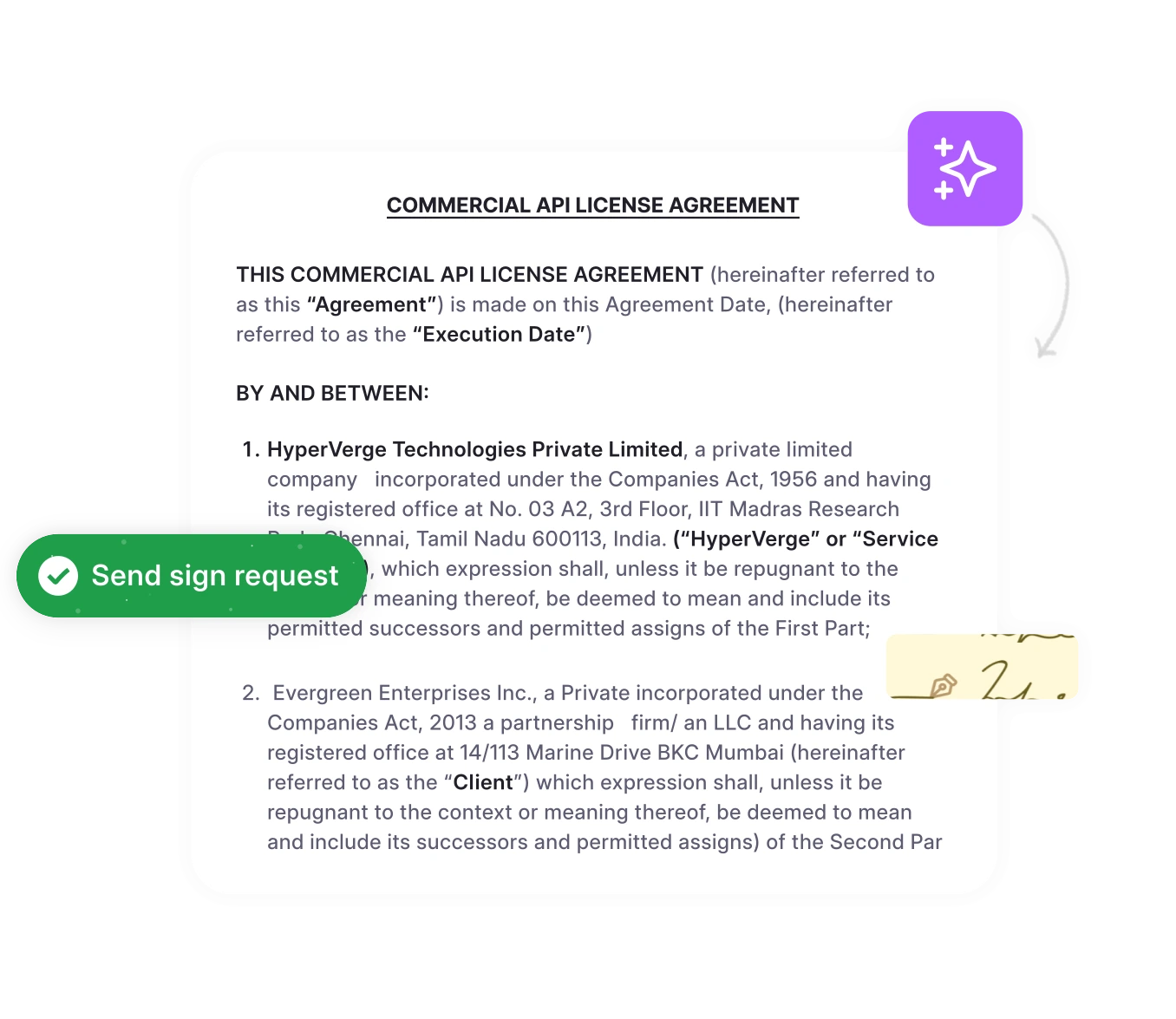Legal teams across organizations often face a daily challenge: a constant influx of contract requests arriving via email, Slack messages, or informal conversations. Without a standardized contract request process, legal teams often spend hours chasing missing information, rather than focusing on strategic, high-value work.
The result? Delayed deals, frustrated business teams, and legal professionals buried in administrative tasks.
This guide shows you how to transform contract request chaos into a streamlined, automated process that can handle requests faster. You’ll learn how to:
- Streamline intake by collecting all required information upfront
- Eliminate bottlenecks that slow down approvals and execution
- Free your legal team to focus on work that drives business growth
By utilizing contract organization software, your organization can streamline the entire contract request process, enhance accuracy, and ensure contracts are executed efficiently every time.
What is a contract request?
A contract request is the formal communication used by internal teams to initiate the creation of a new legal agreement. When someone needs a contract, such as sales personnel requesting customer agreements or HR requiring employment contracts, they submit a contract request with the essential details.
Business users submit request information through intake forms specifying contract type, parties involved, key terms, and deadlines. For example, a sales manager closing a new client deal might submit a contract request for a Master Service Agreement (MSA), which includes the client’s name, service details, payment terms, and the desired execution date. The legal team then uses this request to generate the formal agreement.
According to the National Association of Secretaries of State, modern contract lifecycle management involves “the proactive, automated management of the contract process from generation through negotiation, signature, ongoing management and storage,” with contract requests serving as the critical first stage.
Without a structured request for contract systems, organizations rely on scattered communications that create delays and incomplete information. Understanding what is contract lifecycle management helps teams see how proper requests fit into broader contracting frameworks.
Eliminate contract request bottlenecks
Streamlined workflow that accelerates legal operations and deal closure.
Book a DemoContract requests across departments: types, urgency, and complexity
Organizations handle diverse contract requests across multiple departments, each with unique requirements and urgency levels. Understanding these request types helps legal teams prioritize workload and establish appropriate approval workflows.
From routine contract renewal requests to complex partnership agreements, the variety of requests determines how efficiently your legal operations function.
| Department | Common Request Types | Typical Urgency | Complexity Level |
| Sales | Customer agreements, MSAs, SOWs | High | Medium-High |
| HR | Employment contracts, NDAs, and offer letters | Medium | Low-Medium |
| Procurement | Vendor agreements, supplier contracts | Medium | Medium |
| Finance | Service agreements, consulting contracts | Medium | Medium-High |
| Marketing | Partnership agreements, licensing deals | Low-Medium | High |
| Operations | Facility leases, equipment contracts | Low | Medium |
Each department’s contract requests have unique characteristics that impact how legal teams should handle intake and processing workflows.
Sales contract requests
Sales teams generate the highest volume of requests for most organizations, requiring rapid turnaround to maintain deal velocity. Common requests include customer agreements, master service agreements, and statements of work that directly impact revenue generation. Sales teams often submit urgent requests near quarter-end, creating workflow bottlenecks that effective sales contract management processes can resolve.
HR department requests
Employment-related agreements form the core of HR contract requests, including new hire contracts, contractor agreements, and confidentiality agreements. While less urgent than sales requests, HR contracts require careful attention to employment law compliance and the use of standardized language to minimize legal risks.
Procurement requests
Vendor agreements, supplier contracts, and service provider agreements are the primary requests of procurement teams. Many involve contract change requests for existing agreements when terms need modification due to pricing updates or changes in scope. Procurement teams also handle contract extension request letters for continuing vendor relationships.
Specialized requests
Partnership agreements, licensing deals, and complex commercial arrangements require extensive legal review and contract negotiation. High-value agreements demand significant legal involvement and longer processing times compared to routine contract requests.
Understanding this variety enables organizations to design tailored intake processes for each request type. Different types of contracts require other information, approval levels, and processing workflows, making standardized categorization essential for efficient legal operations.
What are the common pitfalls of the contract request stage?
Contract request processes fail due to preventable organizational issues that create delays and lost business opportunities. Legal teams encounter the same problems repeatedly, resulting in an administrative burden that prevents strategic work.
Understanding these pitfalls helps organizations implement effective contract request management systems.
Pitfall #1: Unclear contract request goals
Business teams submit contract requests without defining what they need or why. Requests arrive with vague descriptions, such as “need a contract for new client,” leaving legal teams to play detective rather than drafting agreements. This creates multiple clarification rounds, delayed timelines, and frustrated stakeholders.
Without clear objectives, legal teams cannot determine appropriate contract types, risk levels, or approval workflows. Sales teams request “simple agreements” for complex partnerships while procurement submits urgent requests without business context.
Solution:
Implement structured contract request forms requiring requesters to specify business objectives, contract scope, key terms, and success criteria before submission. Include mandatory fields for contract purpose, parties involved, and desired outcomes.
Pitfall #2: Inconsistent intake processes
Organizations allow different departments to submit requests through various channels, including email, Slack, phone calls, or informal conversations. Sales teams email legal counsel directly, HR teams use shared drives, and procurement follows entirely different contract workflows.
Without standardized processes, important requests get lost, duplicate efforts occur, and legal teams cannot prioritize effectively. Some urgent requests arrive through unofficial channels while routine requests follow formal procedures.
Solution:
Establish a single, centralized intake system that all departments must use. Create department-specific contract request forms that capture relevant information while maintaining consistent routing. Train stakeholders and enforce usage through management support.
Pitfall #3: Manual routing and approval bottlenecks
Traditional processes rely on manual routing between stakeholders, creating delays when approvers are unavailable or overwhelmed. Email chains become unwieldy, requests get stuck waiting for single approvers, and legal teams lack visibility into bottlenecks. When contracts are processed manually, tracking their status becomes impossible.
Manual workflows create single points of failure. If the designated approver is unavailable, the entire process stalls, potentially causing deals to collapse or vendor relationships to suffer.
Solution:
Implement automated routing and approval workflows with backup approvers, escalation rules, and parallel approval paths. Use contract management automation to route requests based on contract value, type, and risk level. Establish clear approval hierarchies with defined thresholds and alternative approvers.
Organizations addressing these pitfalls see dramatic improvements in legal team productivity and business velocity. Implementing contract management best practices transforms chaotic request processes into streamlined operations that support business objectives while maintaining legal oversight.
How to streamline contract request processes
Transforming chaotic contract requests into organized workflows requires the systematic implementation of proven best practices. These five steps address the core challenges organizations face when establishing efficient contract request management, thereby reducing the legal team’s administrative burden and accelerating business velocity.
Step 1: Create standardized contract request forms
Design comprehensive contract request forms with mandatory fields for contract type, parties involved, key terms, deadlines, and business objectives. Use dropdown menus and conditional logic to ensure complete information capture.
Include contract-specific questions based on agreement type, such as NDAs versus procurement contracts. Make contract request form templates accessible through a centralized platform that guides users through proper legal intake processes.
Step 2: Centralize the request management system
Establish a single entry point for all contract requests, replacing scattered email submissions with a unified digital repository. Provide real-time visibility into request status for all stakeholders.
Establish centralized communication hubs for discussions related to requests. This eliminates lost requests and enables legal teams to prioritize effectively based on business impact and urgency levels.
Best practice recommends maintaining both procurement and contract documents in a single file to provide ready access, avoid duplication or gaps, and provide transparency.
Read
Step 3: Implement automated routing and approval workflows
Set up automatic routing based on contract type, value thresholds, and risk levels. Define approval hierarchies with escalation rules and use conditional logic for complex requirements.
Enable parallel approvals where appropriate to reduce cycle time. Automated contract approval workflows eliminate manual routing delays and provide clear visibility into approval status.
Step 4: Establish clear approval hierarchies and roles
Define specific roles and responsibilities for each workflow stage, including who reviews what contract types and at what value thresholds. Set approval limits based on contract value and risk assessment.
Create backup approvers to prevent bottlenecks when primary approvers are unavailable. Establish document escalation procedures for urgent requests that require expedited processing.
Step 5: Monitor performance and optimize continuously
Track key metrics including processing time, approval delays, request volume, and user satisfaction. Identify bottlenecks through data analysis and gather feedback from requesters and legal teams.
Regular optimization ensures that the system evolves in line with business needs. Integration with automated contract drafting further accelerates the process once requests are approved.
When business users submit request information through these standardized processes, legal teams receive complete, organized data that enables faster contract creation and reduces administrative overhead by up to 80%.
Transform scattered contract requests into organized workflows
AI-powered contract management platforms standardize intake processes, automate routing, and eliminate the chaos of email-based contract requests.
Book a DemoBest practices for contract request routing
Effective routing ensures contract requests reach the right people at the right time without delays or confusion. Smart routing practices reduce bottlenecks, improve response times, and provide transparency throughout the approval process.
1. Implement priority-based routing systems.
Not all contract requests require the same level of urgency. Revenue-impacting sales contracts need immediate attention, while routine vendor agreements can follow standard timelines. Create priority classifications that automatically route high-value requests to senior legal counsel and standard contracts to junior team members.
2. Set up conditional routing logic.
Route requests based on specific criteria, including contract value, type, and complexity. Contracts above certain dollar thresholds should automatically escalate to senior management for approval. Complex partnership agreements require different routing than simple NDAs or employment contracts.
3. Create department-specific workflows.
Sales contracts need different approval paths than HR or procurement requests. Sales agreements may require contract approval from revenue operations, while HR contracts require a compliance review. Design routing workflows that match each department’s unique requirements and stakeholder involvement.
4. Enable parallel processing where possible.
Instead of sequential approvals that create delays, allow multiple stakeholders to review simultaneously when appropriate. Legal review and business approval often happen in parallel, reducing overall processing time. This approach keeps contracts in process, allowing them to move efficiently through the system.
5. Establish backup routing protocols.
Primary approvers aren’t always available when urgent requests arrive. Configure automatic routing to backup approvers when primary contacts don’t respond within defined timeframes. This prevents requests from stalling when key personnel are unavailable.
6. Build escalation pathways.
Create clear escalation rules for requests that exceed normal processing times or require executive attention. Automatic escalation ensures that urgent requests receive the appropriate priority without requiring manual intervention. Senior leadership should receive visibility into escalated requests that impact business operations.
7. Maintain routing transparency.
All stakeholders need visibility into the current status of requests within the approval process. Real-time status updates prevent duplicate requests and reduce follow-up communications. Contract tracking systems provide this visibility automatically.
8. Configure automated notifications.
Set up notifications for key routing events, including receipt of requests, completion of approvals, and routing delays. Stakeholders should receive updates when actions are required or when processing milestones are reached. Automated notifications keep everyone informed, eliminating the need for manual communication.
Effective contract request management routing reduces average processing time while improving stakeholder satisfaction. When requests flow smoothly through predefined paths, legal teams can focus on the content of contracts rather than managing processes.
Organizations that implement these routing best practices experience immediate improvements in request processing speed and reduced administrative overhead for their legal teams.
5 benefits of automating the contract request process
Automation transforms manual, error-prone contract requests into streamlined workflows that deliver measurable business results. Organizations that implement automated request processes experience immediate improvements across legal operations and business velocity.
Benefit #1: Faster processing speeds
Automated contract request systems reduce processing time from weeks to days or hours. Manual routing delays are eliminated when requests are automatically routed to the appropriate reviewers based on predefined criteria.
Key speed improvements include:
- Request intake: Instant routing vs manual forwarding
- Approval workflows: Parallel processing vs sequential delays
- Status tracking: Real-time updates vs email chains
- Information gathering: Complete forms vs multiple clarification rounds
Benefit #2: Improved legal team productivity
Legal professionals spend 80% less time on administrative tasks when businesses submit request information through automated systems. Teams can focus on strategic contract review rather than chasing missing information or managing approval workflows.
Productivity gains include:
- Elimination of duplicate data entry across systems
- Automatic validation of required fields and supporting documents
- Instant access to complete request information and context
- Reduced time spent coordinating between departments
Benefit #3: Better business velocity
Streamlined request processes have a direct impact on business operations and revenue generation. Sales teams close deals more quickly when contract requests don’t create bottlenecks, while procurement teams maintain strong vendor relationships through timely agreement processing.
Business impact areas:
- Sales cycle acceleration through faster contract turnaround
- Reduced deal slippage from contract processing delays
- Improved vendor relationships via predictable processing times
- Enhanced customer satisfaction through responsive legal operations
It is the responsibility of each agency to ensure that all contractual obligations are met and that contract monitoring is properly documented. The agency should keep a complete master contract administration file. This file should provide the basis for settling claims and disputes should they arise in administrative or court actions.
Read
Benefit #4: Enhanced compliance tracking
Automated systems provide complete audit trails and ensure consistent approval processes across all types of contract requests. Built-in compliance checks prevent requests from proceeding without required approvals or documentation.
Compliance advantages:
- Automatic documentation of all approval steps and decisions
- Consistent application of company policies across departments
- Built-in validation for regulatory requirements
- Comprehensive reporting for internal and external audits
Benefit #5: Reduced operational costs
Organizations typically see a 60-80% reduction in contract processing costs through automation. Fewer manual touchpoints mean lower administrative overhead and faster time-to-value for business agreements.
Cost reduction areas:
- Decreased legal team administrative burden
- Elimination of duplicate work across departments
- Reduced errors requiring rework and corrections
- Lower training costs through standardized processes
Advanced contract management software features enable these benefits while providing additional capabilities, such as AI-powered contract analysis and automated renewal tracking. Organizations implementing comprehensive automation see ROI within 6-12 months through improved efficiency and reduced legal operational costs.
Transform your contract request process with HyperStart.
Implementing structured contract request processes transforms legal operations from a state of reactive chaos to one of proactive efficiency. Organizations that follow these proven steps experience an 80% reduction in administrative overhead, faster deal velocity, and improved stakeholder satisfaction. The key is systematic implementation of standardized forms, centralized management, and contract automation software workflows.
Legal teams deserve better than scattered emails and manual routing. Contract request management should enable strategic work, not hinder it. When business users can easily submit request information through organized processes, everyone benefits from predictable timelines and clear accountability.
HyperStart – a contract management platform that streamlines contract requests with intelligent automation and 2-7 day implementation. Our customers, like those who use LeadSquared, achieve complete request process transformation in weeks, not months.
From automated intake forms to intelligent routing workflows, HyperStart eliminates the administrative burden that prevents legal teams from focusing on strategic business objectives.








![8 Stages of Contract Lifecycle Management Process [A Detailed Guide]](https://www.hyperstart.com/wp-content/uploads/2024/05/Blog-70-white-scaled.webp)



